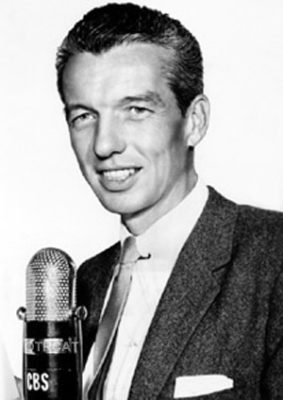
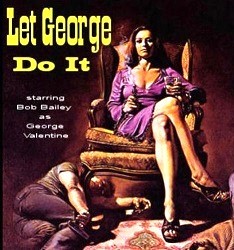 Personal Notice:
Personal Notice:
Do you have a crime that needs solving?
Do you have a dog that needs walking?
Do you have a wife that needs spanking?
Let George do it. Danger’s my stock-in-trade.
If the job’s too tough for you to handle,
you’ve got a job for me,
George Valentine.
Write FULL Details
Let George Do It (1946-54) aired “The Hearse Was Painted Pink” on September 20, 1948, as the 100th of its 414 episodes. The George of the title was an ex-GI now home and trying to find his place in civilian society after the war. Intentional or not, George Valentine, as an “everyman” character the common man could relate to, who exhibited no special abilities to speak of, found his calling as a freelance investigator, but not the usual hardboiled gumshoe in the mold of Mickey Spillane or Sam Spade. Like the character Dan Holiday of the radio program Box 13, who placed a classified ad in the newspaper soliciting his services, George used the same approach—see the Personal Notice above and in the ad below. While the first few lines of the ad would change from time to time the ad always ended with the lines: “Danger’s my stock-in-trade. If the job’s too tough for you to handle, you’ve got a job for me, George Valentine. Write FULL Details.” George’s cases ran the gamut as did those of other private investigators or detectives: theft, blackmail, abduction, scams, political malfeasance or worse, and of course murder. But there were also the oddball cases that provided a welcome freshness and change of pace to the program which would make George Valentine one of America’s more popular radio characters.

George Valentine was played by none other than Bob Bailey (1913-1983, photo top right), who would go on to be the star in one of radio’s most beloved programs, Yours Truly, Johnny Dollar (1949-62), where he would become the most famous of Dollar’s voices from 1955-60. Though he had been a supporting or bit actor in numerous shows before he hit it big as the star of Let George Do It, this was Bailey’s first starring role in a major program, and he made it his own, stepping down for only the final 37 shows (January through September of 1954).
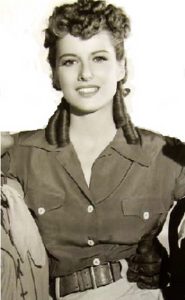 George Valentine’s loyal assistant/secretary and love interest was Claire Brooks, affectionately known as “Brooksie,” who was perfectly played by Frances Robinson (1916-1971, photo at left), and then others including Virginia Gregg who would follow Bailey to Yours Truly, Johnny Dollar as his secretary Nancy Turner. Both Robinson and Gregg would play Brooksie as “smart and sassie” as one source characterized their interpretation of the role, but it was Robinson’s little touches that made her Brooksie priceless, as when she made it clear on more than one occasion that “the case he was the most off base on was the ‘Case of the Missing Engagement Ring.’” The charming way she presented Brooksie to the program’s loyal listeners was evident, which led one critic to comment that “Frances Robinson’s Brooksie remains one of Radio’s most endearing and versatile sidekicks. Lilian Buyeff, Shirley Mitchell and Virginia Gregg would later replace Frances Robinson over the years, but despite their own considerable talents, could never completely erase the memory of Frances Robinson’s absolutely letter-perfect characterization of Brooksie.” Robinson also enjoyed a film and TV career, appearing in more than a dozen films, a couple of interest to science fiction fans include The Invisible Man Returns (1940) and 1941’s Dr. Jekyll and Mr. Hyde. She would die of an apparent heart attack at the much too early age of 55 on August 16, 1971.
George Valentine’s loyal assistant/secretary and love interest was Claire Brooks, affectionately known as “Brooksie,” who was perfectly played by Frances Robinson (1916-1971, photo at left), and then others including Virginia Gregg who would follow Bailey to Yours Truly, Johnny Dollar as his secretary Nancy Turner. Both Robinson and Gregg would play Brooksie as “smart and sassie” as one source characterized their interpretation of the role, but it was Robinson’s little touches that made her Brooksie priceless, as when she made it clear on more than one occasion that “the case he was the most off base on was the ‘Case of the Missing Engagement Ring.’” The charming way she presented Brooksie to the program’s loyal listeners was evident, which led one critic to comment that “Frances Robinson’s Brooksie remains one of Radio’s most endearing and versatile sidekicks. Lilian Buyeff, Shirley Mitchell and Virginia Gregg would later replace Frances Robinson over the years, but despite their own considerable talents, could never completely erase the memory of Frances Robinson’s absolutely letter-perfect characterization of Brooksie.” Robinson also enjoyed a film and TV career, appearing in more than a dozen films, a couple of interest to science fiction fans include The Invisible Man Returns (1940) and 1941’s Dr. Jekyll and Mr. Hyde. She would die of an apparent heart attack at the much too early age of 55 on August 16, 1971.
“The Hearse Was Painted Pink” finds George accepting a handsome fee to romance a pretty nightclub singer. Little does he know that he is being set up as a fall guy between two feuding racketeers whose interests involve the singer, and which puts a bullseye on his back. What the real backstory is and how our man George extricates himself from this dangerous job with, of course, a pretty girl as the baited trap at the center of it all, is the focus for this story where “The Hearse Was Painted Pink.”
Play Time: 29:51
{This episode of Let George Do It aired on a Monday evening, which meant the inevitable trip to the nearby newsstand for the neighborhood gang the next day after school. Looking for more detective-type stories like those they liked from Let George Do It, they were in luck, and in spades. Black Mask (1920-51) was the undisputed king of the hill when it came to the detective pulps, having published among other now classic noir detective stories, Dashiell Hammett’s The Maltese Falcon (serialized beginning in the magazine’s September 1930 issue). Many of the most important names in the business saw their stories between Black Mask‘s covers. It was a bi-monthly in 1948. Detective Mystery Novel (1935-51) began as a weird menace magazine under the title Thrilling Mystery but after a few years switched to more common detective fare under its current (1948) name. Over the years, however, it wasn’t unusual to see the occasional name familiar to SF, fantasy, or horror fans such as Sam Merwin Jr., Henry Kuttner, Ray Cummings, Hugh B. Cave, and even Jack Williamson. It was a quarterly in 1948. Detective Tales (1935-53) proved to be a highly successful detective pulp. It ran for 19 years and just over 200 issues so was obviously doing something right. It was a monthly in 1948.}
[Left: Black Mask, 9/48 – Center: Detective Mystery Novel, Fall ’48 – Right: Detective Tales, 9/48]
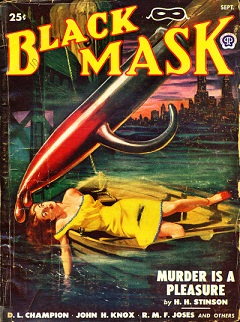
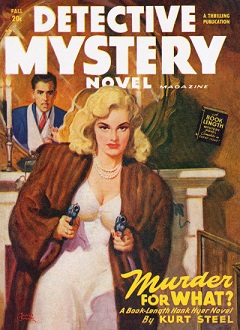
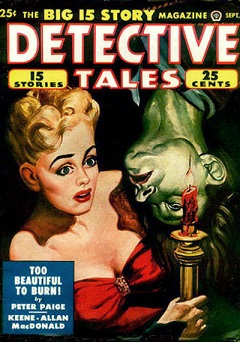
To view the entire list of weekly Old Time Radio episodes at Tangent Online, click here.